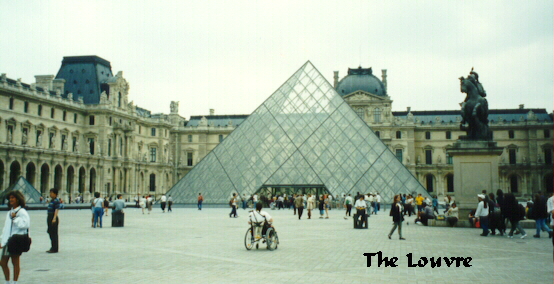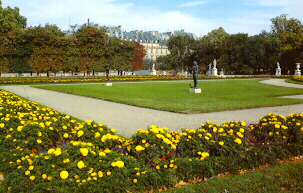
 Paris, the capital of France was founded more than
2000 years ago on an Island in the Seine River. The first recorded
name for this settlement was Lutetia .. "Midwater-Dwelling"
.. and in the early 4th century it became know as Paris.
Paris, the capital of France was founded more than
2000 years ago on an Island in the Seine River. The first recorded
name for this settlement was Lutetia .. "Midwater-Dwelling"
.. and in the early 4th century it became know as Paris.
We arrived at the Charles De Gaulle airport on a beautiful late
afternoon in June of 1996 and went to the Inter-Continental Hotel
on Rue De Castiglione. This elegant 19th century hotel was designed
by Charles Garnier and is ideally located. At the corner was Rue
de Rivoli, which is parallel to the Seine.
 On one side of this street were stores galore, filled
with Limoges, paintings, clothing, souvenirs and cheese sandwiches
on the most tasty French bread. ;-) Place Des Pyramides is situated
here. In the center of the square is a statue of Joan of Arc,
a work done by Fremiet in 1874, which attracts pilgrimages
On one side of this street were stores galore, filled
with Limoges, paintings, clothing, souvenirs and cheese sandwiches
on the most tasty French bread. ;-) Place Des Pyramides is situated
here. In the center of the square is a statue of Joan of Arc,
a work done by Fremiet in 1874, which attracts pilgrimages
every year. We spent a great amount of time strolling along Rue
de Rivoli.

 On the other side of the street is the Louvre and
the Tuileries.
On the other side of the street is the Louvre and
the Tuileries.

The origin of the Louvre dates back to the 13th
century when it was built for defensive purposes. In the 1500's
the fortress was demolished and the new palace was erected under
Henry II. After his death his widow, Caterina de Medici had the
Tuileries Palace constructed and united it to the Louvre by means
of a long wing which extended toward the Seine. It was further
enlarged under Louis XIII and Louis XIV. Napoleon III had the
north wing finished in 1852. It was Frances I in the 16th century
who began a collection of art works, the first of what was to
become one of the most important collections in the world. This
was enlarged under Louis XIII and Louis XIV. In 1793 the gallery
was opened to the public and thus became a museum.


The Garden of the Tuileries stretches from Place
du Carrousel to Place de la Concorde. The ground was bought by
Catherine de Medici in 1563 to create an English style garden.
The Carrousel Arch was built in the early 1800's to celebrate
the victories of Napoleon Bonaparte.


Two blocks in the opposite direction of the hotel
is the world famous square, Place Vendome which received it's
name from the fact that the Duke of Vendome had his residence
here.

It is octagonal in form and surrounded by buildings
which have large arches on the lower floor and crowned, on the
roofs, by numerous dormer windows. At number 15 is the famous
Hotel Ritz (where we couldn't get passed the lobby guard because
we had sneakers on ;-)) at number 12 is the house where Chopin
died in 1849 and many elegant shops. In the center of the square
stands a column erected in honor of Napoleon I, which was inspired
by the Column of Trojan in Rome. It stands 145' high and on the
top is a statue of Napoleon.